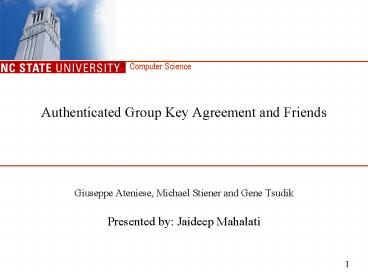Authenticated Group Key Agreement and Friends - PowerPoint PPT Presentation
1 / 16
Title:
Authenticated Group Key Agreement and Friends
Description:
G unique subgroup of Zp ; of order q with p, q prime. q order of the ... ri random (secret) exponent Zp generated by Mi. Sn group key shared among n members ... – PowerPoint PPT presentation
Number of Views:25
Avg rating:3.0/5.0
Title: Authenticated Group Key Agreement and Friends
1
Authenticated Group Key Agreement and Friends
- Giuseppe Ateniese, Michael Stiener and Gene
Tsudik - Presented by Jaideep Mahalati
1
2
Outline
- Introduction
- Group Key Agreement
- Goals and Definition
- Authenticated Group Key Agreement Protocols
- Complete Group Key Authentication
- Conclusions
- Future Work
3
Group Key Agreement
- Definition
- It is a key establishment technique whereby a
shared secret is derived by two or more specified
parties as a function of information contributed
by each of these, such that no party can
predetermine the resulting value. - Goals
- Perfect Forward Secrecy (PFS)
- Resistance to Known-Key Attacks
- Key Authentication
- Key Confirmation an Key Integrity
4
Few More Definitions
- Perfect Forward Secrecy
- Compromise of a long term key(s) cannot result
in the compromise of past session keys. - Known Key Attacks
- Protocol is vulnerable to known key attack if
compromise of past session keys allows 1) a
passive adversary to compromise future session
keys, or 2) An active adversary to impersonate
one of the protocol parties. - Key authentication
- Key authentication is the property obtained when
performing a key establishment protocol and one
entity has the assurance that only a particularly
identified other party may possibly know the
negotiated key. - Key Confirmation
- If a party is assured that its peer actually has
possession of a particular secret key - Key Integrity
- If a party is assured that its particular secret
key is a function of only the contributions of
all protocol parties.
5
Authenticated Group Key Agreement
- Definition
- Key agreement protocol which provides implicit
key authentication - Notations Used
- n number of protocol parties (group
members) - i,j indices of group members
- Mi i-th group member i ? 1, n
- G unique subgroup of Zp of order q with p,
q prime - q order of the algebraic group
- a exponentiation base
- xi long-term secret key of Mi
- ri random (secret) exponent ? Zp generated
by Mi - Sn group key shared among n members
- Sn(Mi) Mis view on a group key
- Kij long-term secret shared by Mi and Mj,
with i ? j
6
Authenticated GDH.2 protocol
- Few points to note
- Mn shares with each Mi a distinct secret Kin
- Kin F(axi. xn mod p) with i ? 1, n-1 F()
such that - F(x) x mod q or F(x) h(x) h hash
function - xi is the secret long term exponent selected by
each Mi (1 xi q-1) and - axi mod p is the long-term public key of Mi
7
A-GDH.2 Contd..
8
A-GDH.2 Contd..
- Key is not directly authenticated between
arbitrary nodes - Is a contributory authenticated key agreement
protocol - Provides perfect forward secrecy
- Resistant to passive known key attacks
- Weak form of key authentication
- Key is not arbitrarily authenticated between Mi
and Mj, where i ? j - Instead, all key authentication is performed
through Mn - Assumes that Mn is trusted , which may not be the
case always.
9
Complete Group Key Authentication
- Let R be an n-party key agreement protocol and M
be a set of protocol parties. We say that R is a
complete group key authentication protocol if,
for every i, j (0 lt i ? j n) Mi and Mj compute
the same key Si,j, only if Si,j has been
contributed to by every MP ? M. - A-GDH.2 can be extended to provide complete group
key authentication.
10
SA-GDH.2 (with complete group key authentication)
- Most significant change is the requirement for
the prior availability of all members long-term
credentials - Each Mi must have two shared keys with every
other Mj - For every ordered pair (i,j) (0 lt i ? j n)
- Keys for each direction.
11
SA-GDH.2 (with complete group key authentication)
12
SA-GDH.2 Contd..
- Advantages
- Provides complete key authentication, resistance
to known-key attacks. - Each member can be aware of the exact group
membership - Protocol is computationally symmetric
- Each member does the same sequence of
computational steps and exponentiations
13
SA-GDH.2 Contd..
- Drawbacks
- More expensive than AGDH.2
- Needs n-1 exponentiations from every member
during stage 1 - If paired keys are not pre-computed as many as
n-1 additional exponentiations may be required
14
Conclusions
- Analyzes the requirements and issues in
authenticated, contributory key agreement. - Presents extension of security services and
protocols for Dynamic Peer Groups. - Incorporates services like key authentication,
key confirmation and entity authentication into
group key agreement.
15
Future Work
- Develop a general-purpose toolkit for key
agreement and related security services in
Dynamic Peer Groups. - Implementing these security protocols for voice
conferencing over IP, replicated Web servers and
private mailing lists.
16
- THANK YOU































